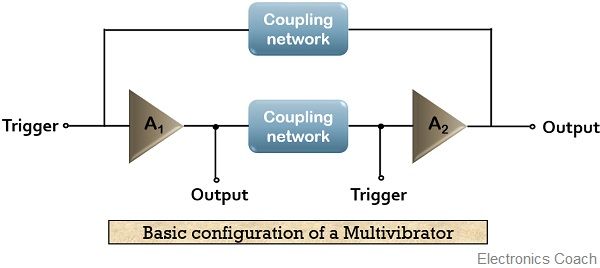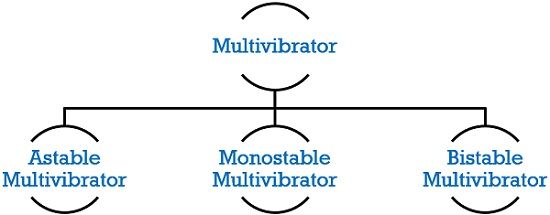Definition: An electronic device that produces a non-sinusoidal waveform as its output is known as a Multivibrator. The generated non-sinusoidal waveforms are basically a square wave, rectangular wave, a triangular wave, sawtooth wave, or ramp wave etc.
It is a 2 stage RC coupled amplifier that operates in two modes. The modes are basically termed as states of the multivibrator.
Basics of Multivibrator
The multivibrator is a switching circuit and its basic configuration is shown below:

Here, two amplifiers are employed in which the output from the 1st stage acts as input to the 2nd stage. The output of the 2nd stage is then through a feedback path is provided to the input of the 1st stage.
Here, the operation of the circuit is controlled by two conditions on and off of the circuit. It performs oscillations between high and low state i.e., 0 and 1 thereby generating a continuous output.
A multivibrator has the ability to store binary number, count pulses and at the same time synchronization between the arithmetic operations is also maintained by the multivibrator in a digital system.
Types of Multivibrators
The various types of coupling network are basically categorized by the type of coupling network that is employed in the circuit of the multivibrator. These are as follows:
 1. Astable multivibrator: It is a type of multivibrator also termed as a free running multivibrator. It is called so because here the state changes on its own after some predetermined time interval and thus does not require a triggering pulse.
1. Astable multivibrator: It is a type of multivibrator also termed as a free running multivibrator. It is called so because here the state changes on its own after some predetermined time interval and thus does not require a triggering pulse.
Here, the output of the circuit simply oscillates between high and low state freely. Hence is just an oscillator.
The figure below shows the configuration of an astable multivibrator:

The coupling network employed in astable multivibrator with the help of a coupling capacitor provides ac coupling to the amplifier.
A phase shift of 180° is provided by each amplifier stage in the mid-band, thereby generating a total phase shift of 0° or 360°. Hence providing positive feedback.
Thus, the circuit has no stable state, and the two states are merely temporary ones termed as quasi-state.
So, a continuous output is generated by performing successive transitions from one state to another after a fixed time duration. It is to be noted here that the time duration of switching between one quasi-state to the other depends on the time constant and other parameters of the circuit.
2. Monostable Multivibrator: As the name here itself is indicating that it has a single stable state and a quasi-state.
Here, out of the two coupling networks, one provides ac coupling and the other provides dc coupling. Thus, providing one stable and one quasi-state.
The figure below will help you to understand the basics of monostable multivibrator:

Unlike the astable multivibrator, here, a triggering pulse is required in order to have transition from the stable state to the quasi-state. However, in order to have transition again from quasi-state to a stable state no any triggering pulse is provided.
So, to have a stable state again, a predetermined timing interval is provided as given in case of the astable multivibrator.
Thus, after a certain time period decided by the time constant, the circuit comes back to its initial state i.e., the stable state without the need of external signal.
3. Bistable multivibrator: A bistable multivibrator has 2 stable states. Here, a separate trigger pulse is required in order to have transition from one stable state to another stable state.
Here, only dc coupling is provided by the coupling networks and hence the energy storing element is not required.
Let us have a look at the pictorial configuration of a bistable multivibrator.

When the trigger pulse is first applied, the transistor in the circuit gets cut-off thus showing an off stable state. However, as another triggering pulse is applied, the transistor again starts its conduction. Thereby changing its state from one state to another.
As the overall operation depends on two triggers, these circuits are also termed as flip-flops or trigger circuits. For the purpose of counting and storing binary elements, bistable multivibrators are used.
Applications of Multivibrators
Astable Multivibrators finds its applications in delay and timing circuits and in transmission and reception of radio signals.
Monostable multivibrators are majorly used in analog systems in order to control the frequency of the signal at the output. These are also used for regenerating a distorted pulsed signal.
Bistable multivibrators are also used as a frequency divider, counters, latches and in memory storage units.
So, we can conclude that a multivibrator generates rectangular, triangular, ramp or square waveform as its output. At the same time, it has the ability to store binary information and synchronizing multiple operations of a digital system.
Emmanuel Alvin says
good